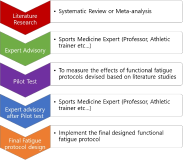
Purpose The purpose of this study was to investigate the effects of a functional fatigue protocol on lower extremity dynamic and static postural control. Methods A total of 20 physically active collegiate students participated in this study (ten males, ten females; age 22.5±2.7 years; mass 67.0±13.0 kg; height 168.0±8.9 cm). A unilateral stance with eyes closed for 10 seconds was performed to test static postural control using a balance force plate and single-leg drop landing on 30cm box was performed as a dynamic postural control test and captured using VICON motion analysis system. Results The results of this study showed an average heart rate of 176.3 beats/minute, an 18 rating on the perceived exertion scale, significant differences in blood lactate, and a static postural control deficit after fatigue as compared with before fatigue(p<.05). Dynamic postural control after fatigue changed landing strategy in the form of stiff landing. Knee flexion was decreased at initial contact and at peak vertical ground reaction force, also, both decreased valgus and internal rotation of knee joint. Conclusions This protocol may use for enhancing fatigue-endurance training as well as for inducing fatigue. Further, to ascertain a landing strategy, it is recommended to increase landing height to clearly observe changes in landing strategy.





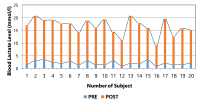
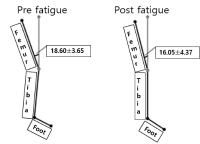

This study aims to suggest the guide line for weight category sports(Taekwondo, Judo, Wrestling, Weightlifting, and Boxing) who have to lose weight to pass weigh-in before games. Reference data was collected from RISS, Medline, PubMed, SciELO and effects of short term weight loss on physiological variables(body composition, physical fitness, blood components, oxidative stress and hormone, immune function) were analyzed. Also, weight loss procedures for weight category sports athletes were analyzed in details. The results of the research are as follows: weight category sports athletes prefer short term (3~5 days) weight loss methods (3~5%) with dietary control, sweating and exercise. Physical changes caused by the loss in body weight, fat-free mass, and BMI, however, do not affect body fat percentage. Different changes of physical strength element depend on weight reduction period. In short term weight loss method, anaerobic exercise capacity, muscular strength, and reaction time partially decrease and affect staying power. In contrast, long term weight loss method do not affect aerobic and anaerobic exercise capacity. Furthermore, most of previous studies show that blood component change has negative effect on body water balance, stress-related hormone, and immune function. In conclusion, short term weight loss method negatively affects athletic performance of weight class competition athletic. Therefore, careful long term weight loss methods are recommended with dietetic consideration to prevent dehydration during weight loss period. Excessive weight loss on lightweight athlete should be prevented by institutional basis as well.
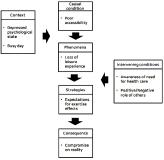
Purpose The purpose of this study is to investigate the alienation and the overcoming process of the physical activity participation of people with Adventitious Visual Impairment(AVI) Methods 21 Adults with AVI were recruited and one on one semi-structured interview was conducted. Ground theory was used to analyze the data. Member check, peer debriefing was conducted to enhance the trustworthiness of this study. Results As a result, a total of 203 concepts were derived. This consisted of 21 subcategories and the common themes of the subcategories were categorized into nine categories. Specific results are as follows. First, the physical activity of people with AVI was directly affected by the sports facilities, physical activity programs, and professional instructor. This causal condition resulted in the loss of leisure experience in the context of the busy daily life and the depressed psychological state. Second, due to the perceived need of health care and the positive involvement of others, people with AVI came to expect the effect of exercise. Third, people with AVI participated in physical activity again as a tool to achieve the purpose of health improvement. This type of physical activity has a limitation that it can not guarantee the continuity of physical activity due to the limitation that it does not contain autonomy and interest of people with AVI. Conclusions Based on these results, the following suggestions were made. First, it is necessary to improve the environment for ensuring participation in physical activity of people with AVI. Moreover education and promotion of the effects and values of the exercise should be carried out for people with AVI and their guardians. Second, it is necessary to diversify physical activity types and reconstruct existing exercise programs.

PURPOSE High blood pressure and obesity pose significant health problems for older individuals. Previous studies showed that regular exercise improves physical fitness factors and decreases blood pressure and obesity. Therefore, this study investigated differences in blood pressure and obesity according to the physical fitness level of Korean older individuals using the National Fitness 100 data and used them to recognize the importance of maintaining physical fitness through regular physical activity or exercise for older individuals. METHODS From 2013 to 2019, a total of 218,848 subjects (men=74,271, women=144,577) aged ≥65 years who participated in the National Fitness 100 had their muscular strength, muscular endurance, cardiorespiratory endurance, balance, coordination, and flexibility measured, and they were ascribed a fitness level. Blood pressure, body mass index (BMI), percentage of bodyfat, and waist circumference were measured to compare the difference in fitness level. RESULTS There was a significant difference in the systolic and diastolic blood pressure in older men, and the diastolic blood pressure of older women by the fitness level (p<.001). In both older men and women, there was a significant difference in BMI, percentage of bodyfat, and waist circumference according to the fitness level (p<.001). CONCLUSIONS In conclusion, men and women showed different aspects in blood pressure, but Korean older individuals with having a high level of fitness managed their weight and body fat well. The decrease in obesity and improvement of physical fitness through regular physical activity and exercise could be a positive effect on maintaining health and extending healthy life years.
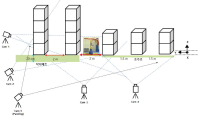
[Purpose] The purpose of this study was to compare Yeo 2 vault and YANG Hak Seon vault to verify the possibility of YANG Hak Seon vault. [Methods] The YANG Hak Seon vault and Yeo 2 vault performed by five Korean national gymnastic athletes, and the photographic images were collected using a high-speed camera and their kinematic characteristics were analyzed by 3D image analysis. [Results] The main variable of the post-flight phase S1, S4, and S2 were similar to YANG Hak Seon vault. S1 showed the largest at shoulder angle and the highest body center of mass at horse take-off. S4 showed the smallest shoulder angle at horse take-off, slow twisting at the post-flight ascending period, but faster femoral rotation during horse contact. S2 showed the slowest twist velocity in the ascending period of the post-flight and the smallest rotational distance and twist distance at the peak. S3 showed the slowest horse take-off velocity, the least time in the post-flight phase, and the hip joint was flexed at the peak. [Conclusions] S1 is required to increase the twist velocity by narrowing the shoulder angle during post-flight. S4 is required to strong push-up and an increase in the twisting velocity in the post-flight ascending period. S2 is required to shorten the horse contact time and increase the horse take-off angle through powerful femoral rotation after board take-off. S3 will have to get enough power from the preparation phase.

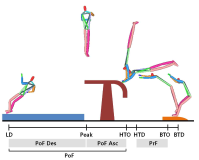



Purpose This study was conducted to investigate the appropriateness of the concept of condition for athletes and to conceptualize condition in a way suitable for field and then to produce a tool to test condition that reflects usability. Methods 30 college athletes and national athletes with more than 5 years of experience were selected. In the conceptual review stage, the appropriateness of the concept of condition was verified. In the conditional element collection stage, the condition concept reflecting usability was extracted. In the development stage of the conditional questionnaire, a condition questionnaire was developed in consultation with the data provider to reflect usability. Results Previous studies on the condition of athletes were complicated and the necessity for consideration of usability was raised. As a result of conceptualization with consideration of the application to the sport scene, condition in a scene is summarized into both physical and psychological states. As a result of the appropriateness evaluation of the tool that produced the condition inspection tool reflecting the condition element based on universality and peculiarity of conditionality, the athletes evaluated that the condition inspection tool properly reflects condition, is easy to apply and can be used for condition control. Conclusion The development and application of psychological testing instruments reflecting usability will accelerate the application of sports psychology in the appropriate direction. The reflection of usability will contribute not only to the reliability and validity of the psychological testing tools used in the field of sports psychology, but also to the improvement of the possibility of intervention by leaders and athletes, the convenience of development procedures, and the utility of response results.


Sport Imagery Questionnaire of Hall et al.(1998) was developed to investigate the imagery type of athletes objectively. The purpose of this research is to verify validity and reliability of Korean SIQ by using Rasch Model, in order to make up for complement drawback of SIQ which was developed only using factorial analysis. This research conducted first and second questionnaire survey. Second survey was conducted targeting different study participants from those of first survey. The participants of first survey was 265 athletes of Chungcheong Province, and the participants of second survey was 169 athletes of Chungcheong Province. SPSS 21, Winstep 3.62, and AMOS 18 was used for date analysis. The result of Rasch Model verification for the data of first survey revealed that 8 items of SIQ were unfit. Thus, 5 factors and 22 items were determined. 7 point Likert scale was revealed to be a good fit. The result of Confirmatory Factor Analysis for the data of second survey revealed that Construct Validity of 5 factors and 22 items was valid and reliability was high by recording Cronbach’α value .954. External Validity was revealed to be high by showing that correlation between sport confidence and MG-M imagery was high.

Purpose The purpose of the study was to determine difference of body composition, bone mineral density and health-related fitness by physical activity level in young women. Methods A total of 90 women aged 19-29 years participated in this study. The subjects were divided into three groups (low, middle, and high level) according to the physical activity level estimated by bone-specific physical activity questionnaire(BPAQ). Body height and weight were measured. Body composition parameters including four sites of bone mineral density(BMD) were estimated by DXA (Hologic, QDR-4500, USA). Health-related fitness tests was assessed using sit & reach, grip strength, sit-ups, and VO2max. Statistical analysis was performed using SAS version 9.4. All data were presented in terms of means and standard deviations. One-way ANOVA was applied to determine difference of dependent variables by physical activity level. Duncan's multiple range test was used as a post-hoc test. The statistical significance level was set at p < .05. Results There were significant differences on body weight(F = 4.867, p = .01), body mass index(F = 5.053, p = .008) and fat-free mass(F = 8.364, p = .0001) among the three groups. Significant differences were found on whole body BMD(F = 16.730, p = .0001), lumbar BMD(F = 11.480, p = .0001), femur BMD(F = 42.182, p = .0001) and forearm BMD(F = 5.560, p = .005) among the three groups. There were also significant differences on sit and reach(F = 11.433, p = .0001), sit-ups(F = 17.972, p = .0001), VO2max(F = 3.106, p = .05) and duration of GXT(F = 7.479, p = .001). Conclusions There were differences on body composition, bone mineral density and health-related physical fitness by physical activity levels. Nevertheless, the questionnaire used in this study was not able to judge participation in various exercise types including aerobic exercise or resistance exercise. Therefore, in the future study, longitudinal study considering various types of physical activity and dietary intake will be needed.
PURPOSE Increased body mass index (BMI) increases ankle instability and adversely affects human movement. This study aims to compare and analyze the muscle function and proprioception of the ankle joint based on Body Mass Index (BMI) to determine potential differences. METHODS Twenty-eight healthy male and female college students were categorized into overweight (≥ BMI 23) and normal (< BMI 23) groups. Measurements included BMI, isokinetic strength of dorsiflexion, plantarflexion, eversion, inversion, ankle joint range of motion, and ankle joint proprioception. RESULTS In dorsiflexion, right 30°/sec (p=.035), left 30°/sec (p=.009) and right 120°/sec (p=.011); in plantarflexion, left 30°/sec (p<.001), right 120°/sec (p=.007) and left 120°/sec (p=.006) in ankle inversion, left 30°/sec (p=.001), right 120°/sec (p=.021) and left 120°/sec (p=.007), left 30°/sec (p=.014), 120°/sec (p=.001) in ankle inversion-eversion ratio, right (p=.003) and left (p=.003) in ankle joint range of motion, right (p<.001) and left (p=.022) in total proprioception, and left (p<.001) in left-right proprioception were significantly different between the normal and overweight groups. CONCLUSIONS It was found that the overweight group had lower muscle strength, joint range of motion, and proprioceptive control function of the ankle joint than the normal group according to BMI. Therefore, exercise programs should be provided to strengthen the periarticular muscles involved in ankle movement, such as the tibialis anterior, soleus, and peroneus longus, and to control dynamic proprioception to prevent ankle injuries and function of the ankle joint according to BMI.
The purpose of the study is to find the impact of social and economic factors in physical activity of children and youth. This study utilized the data from 4th Korean Children and Youth Panel Study(KCYPS), and the analysis were carried out based on the starting sample of 2,009 from ‘the elementary 4 panel’ and 1,978 from the ‘middle school 1 panel’ and 1,984 from the ‘high school 1 panel’, 5,971 full data were used in the final analysis. Data were processed using hierarchical regression analysis and it was statistically validated at the significance level of 0.05. First, Pearson r and Spearman ρ showed that all variables are statistically significant correlations. Second, among the first factors of personal and family characteristics, household income level(B=.113), family composition(B=-.049) and parental education (B=.060) were found on a significant impact on the movement of physical activity time, parental education (B=.027) was found on a significant impact on the subjective evaluation of physical education grades. Third, among the second factors of community-level characteristics, Gini coefficient (B=-.810), wealth concentrating (B=.120) were found on a significant impact on the movement of physical activity time, the Gini coefficient (B=-0.315) was found on a significant impact on the subjective evaluation of physical education grades. Additional factors that determine the coefficient of variation in the level 2 were found to be 0.623 and 0.001 respectively. Therefore, second factors of community-level characteristics are added such as Gini coefficient, wealth concentrating were explained to children and youth exercise time during physical activity 62.3%(p<.01) and subjective evaluation of physical education in grades 0.1%(p<.01). predictive power to